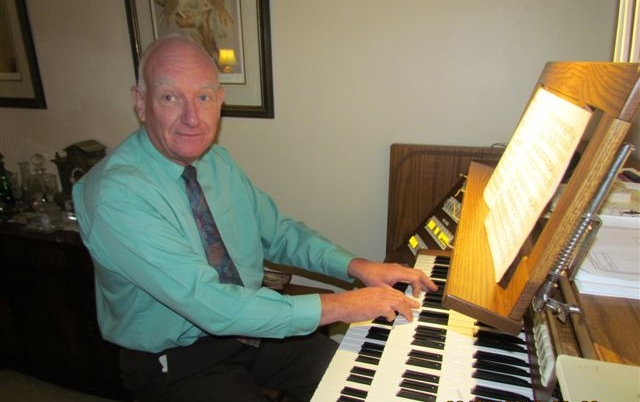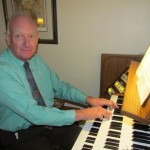Tony would be delighted to welcome organists contemplating the purchase of a Viscount to explore his home installation. If you are interested to do this please first call Viscount to be given Tony’s contact information.
I have wanted for some time now to share my experience in purchasing a new organ for my home use. I was concerned that any such attempt could be interpreted as over enthusiasm for a particular supplier rather than well-informed decision made on my part. I hope I have achieved this.
While thinking about this I realised that there might well be a lot of people out there who could benefit from sharing this experience so here goes. I’ve also realised that this experience is of relevance not just to home-owners but churches and other musical establishments.
What motivated this journey? I’ve always loved church and organ music but being self-taught and not particularly good felt it necessary to be able to practice on my own and not make others suffer.
What sort of organ do I want? Well I wanted one that sounded, touched and felt just like a full-size pipe organ that I have had the privilege to play and experience a few times in my life. I wanted a wide range of stops but also had a liking for the many schools of music and resulting organ designs and voicing. I wanted three manuals and a full-size pedal board. I wanted the normal playing aids you find on a larger instrument such as toe and thumb pistons. Despite this rather grand desire my experience which would like to share with you is just as applicable whether it’s one or four manuals and whether it’s 10 or 50 stops.
The first choice might well have been a pipe organ but as usual there are constraints. In my case I still wanted to be able to live in my house rather than in an organ chamber. Like churches and other establishments I had financial constraints. I could perhaps buy a very modest one manual and 10 stop pipe organ but then I wanted to experience a wide ranging spectrum of music and sound.
One choice only then was a pipe less organ with the benefit of size and cost of ownership.
Only then did the journey begin. The first stumbling block was the limitation of the packages provided by suppliers. I would find an instrument that had enough stops and playing aids but if I wanted internal speakers then I had to choose another range. If I finally accepted a model with external speakers then there were generally none in the console so I had to have enough external ones to do a reasonable job. I then found that I was frequently required to have a certain number of speakers regardless of the space I had. I was offered a compact solution where the entire speaker units could be compressed into fewer cabinets but this had the problem of acoustic interference between the different speakers and restricted sound picture.
I felt I had no choice but to go down the custom-built route but the prices quoted were daunting and beyond my pocket as it is for most small churches.
Most suppliers could provide multiple voicing and as an extra additional voices, or replacement voices. With most suppliers extra voices and some playing aids were often optional extras at additional cost.
I wondered why I could not plug and play and get an organ that fitted my requirements but had a better price.
On a whim of fancy contacted Viscount and did not expect other than the standard answers that I had elsewhere. To my surprise my initial questions were answered with “yes we can do that”. I was suspicious at first but my first contact with the technical manager who is also the service manager explained why this might be possible.
I now realise that the Viscount range of organs gets as near as it can to buying a custom model but off-the-shelf. This is why the cost can be so attractive and you can buy one instrument and get it to do what you want, rather than having to choose from a range of models or resorting to a custom-built one.
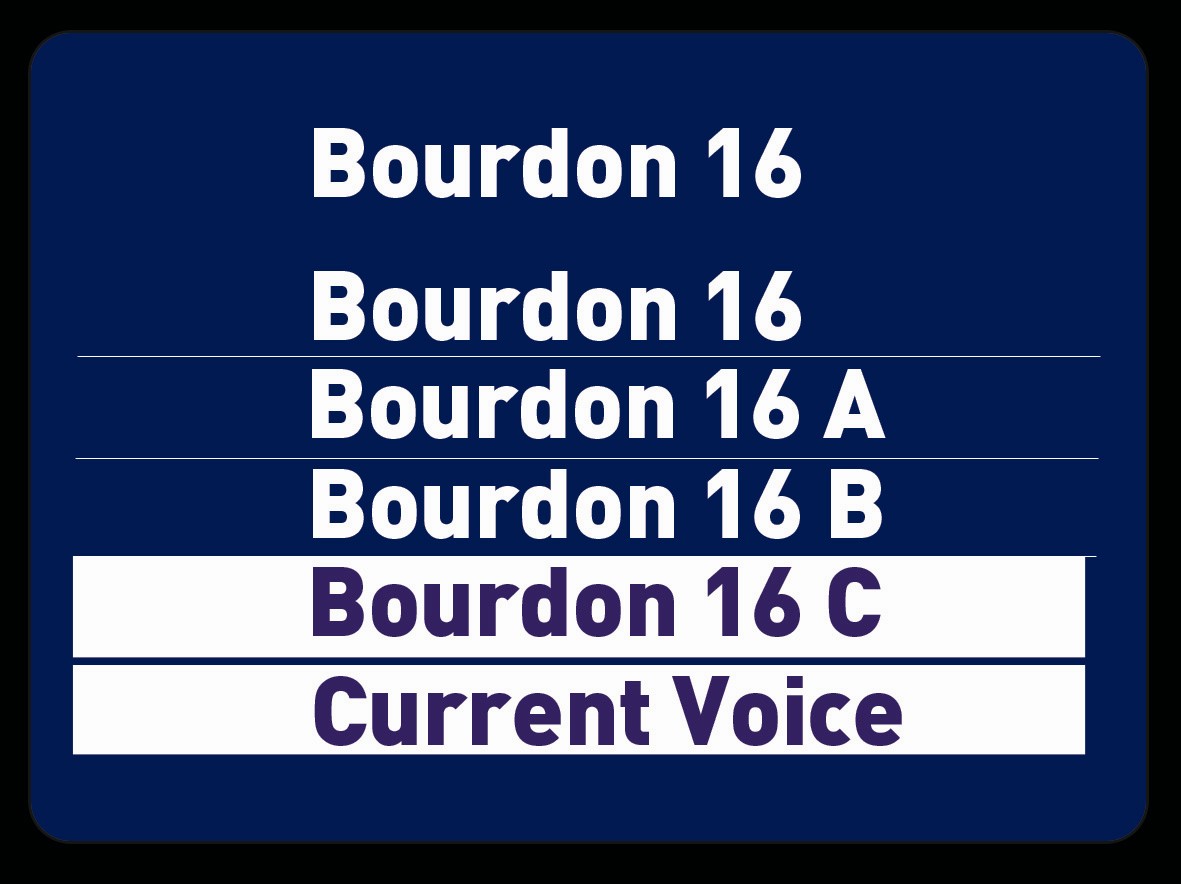 So what is so special about the Viscount range of organs especially within the Regent range? Yes you have the typical four different voicing’s as with other suppliers but when you open the box you immediately find you’ve got so much more. For each voice the organ comes with a range of 40 alternative voices per stop.
So what is so special about the Viscount range of organs especially within the Regent range? Yes you have the typical four different voicing’s as with other suppliers but when you open the box you immediately find you’ve got so much more. For each voice the organ comes with a range of 40 alternative voices per stop.
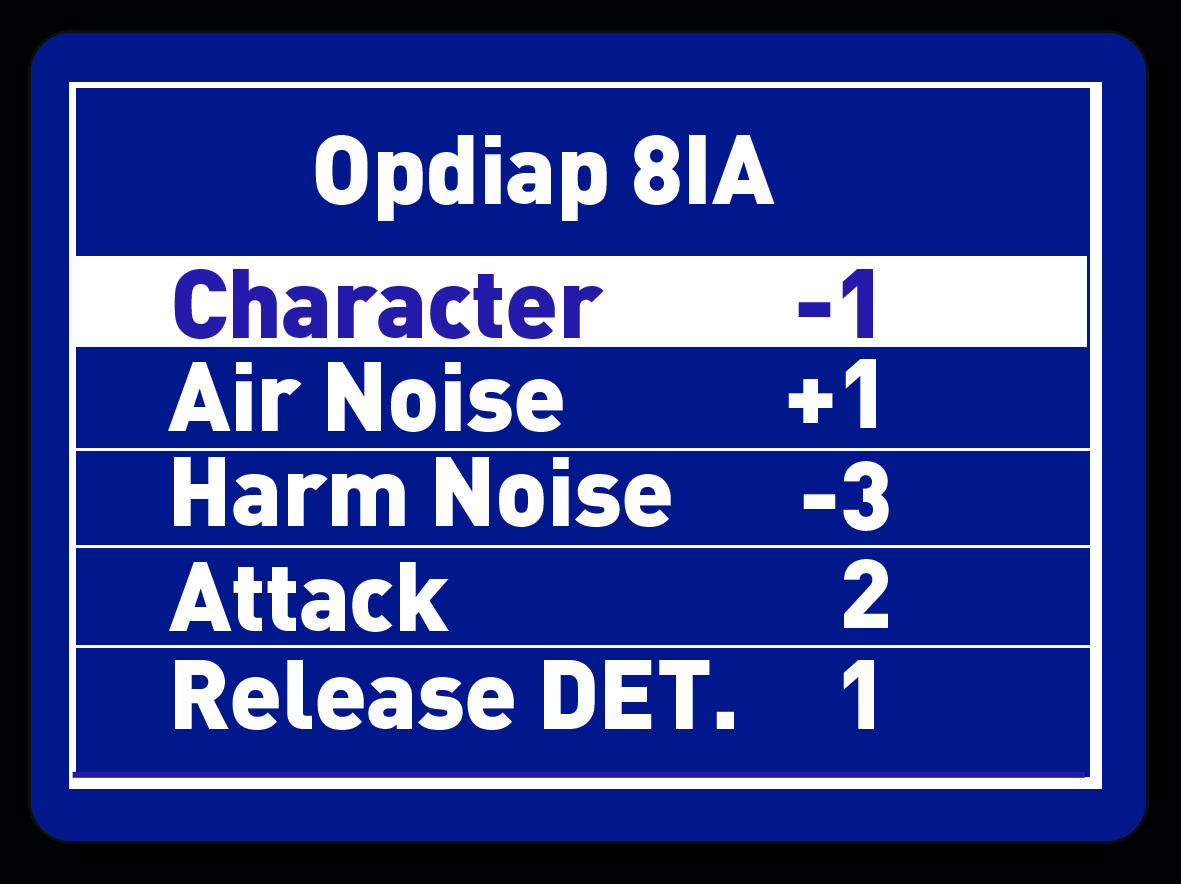 If that’s not good enough for you then you can change the voicing of each of those stops infinitely. You can alter the scale and make it stringier or more like a flute. You can vary the wind pressure, attack and you can vary the way the reeds speak. You can vary the way the organ responds to multiple pipes opening on the same wind chest.
If that’s not good enough for you then you can change the voicing of each of those stops infinitely. You can alter the scale and make it stringier or more like a flute. You can vary the wind pressure, attack and you can vary the way the reeds speak. You can vary the way the organ responds to multiple pipes opening on the same wind chest.
Now don’t panic you don’t need to set this up yourself, the excellent installation team will do it all for you. They begin by listening to and quite happily discussing your requirements and any constraints you may have. They identify the model and speaker arrangement that will suit you. On the installation day they make certain that it is set up just as you wanted. Once you get confident with the instrument as I feel I have there is much more to gain. Exploring this wide range of tailoring that is at your fingertips on the console or plugged in computer can be very rewarding. Every voice, thumb and toe piston is configurable and even groups of settings can be managed separately.
Does this configurability then have more surprises up its sleeve? I could not believe it because it most certainly does. Most organs from alternative suppliers as I’ve already said either had internal or external speakers. If you had external speakers then you had to have the number of channels they decided. It also seemed that you had to accept on the standard models and whatever stops were sent to whichever channels. Not on the Viscount.
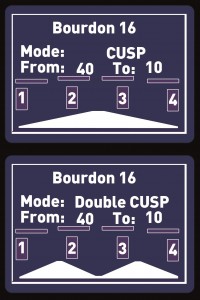 We are all familiar with looking at the external displays on pipe organs with you start with large pipes reducing to small in the middle rising to big pipes at the edge often known as a cusp. The cusp can be inverted and even be a double one. Quite common in concert halls are rows pipes tapering from one side or the other. In any organ these pipes and the chest they are mounted can be set at different heights above the ground. Such pipes such as fanfare trumpets are often mounted in a particularly dominant position generally centre of organ. Would you believe it with whatever speaker setup you’ve got you can create the effects above with surprising ease? These displays show the sound being spread between 4 speakers in two different acoustic patterns.
We are all familiar with looking at the external displays on pipe organs with you start with large pipes reducing to small in the middle rising to big pipes at the edge often known as a cusp. The cusp can be inverted and even be a double one. Quite common in concert halls are rows pipes tapering from one side or the other. In any organ these pipes and the chest they are mounted can be set at different heights above the ground. Such pipes such as fanfare trumpets are often mounted in a particularly dominant position generally centre of organ. Would you believe it with whatever speaker setup you’ve got you can create the effects above with surprising ease? These displays show the sound being spread between 4 speakers in two different acoustic patterns.
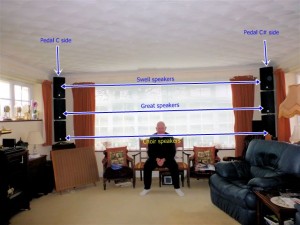 In my case speakers are set up in simple stereo pairs stacked three high and when you set up a typical cusp the sound of each pipe moves in a picture created between the two chosen speakers just as you would experience standing in front of a row pipes. If you have the space such as in a church or concert hall then a horizontal row speakers can be put in place and then the resulting sound moves seamlessly across that whole row. Having different rows or pairs of speakers at different heights enables the creation of everything the makes a pipe organ so special. A distinct positive or choir section low down behind or with the player, a brilliant read section topping the organ, pedal towers nestling either side of the organ and the great and swell speaking from across the whole breadth of the instrument but at different heights.
In my case speakers are set up in simple stereo pairs stacked three high and when you set up a typical cusp the sound of each pipe moves in a picture created between the two chosen speakers just as you would experience standing in front of a row pipes. If you have the space such as in a church or concert hall then a horizontal row speakers can be put in place and then the resulting sound moves seamlessly across that whole row. Having different rows or pairs of speakers at different heights enables the creation of everything the makes a pipe organ so special. A distinct positive or choir section low down behind or with the player, a brilliant read section topping the organ, pedal towers nestling either side of the organ and the great and swell speaking from across the whole breadth of the instrument but at different heights.
So what of the sound it produces? Yes without being this being good all of the tailoring above would be worthless. I will explain below why this sound production is so good through state-of-the-art technology.
In my time I’ve owned a pipe organ, a Compton organ with tone wheel sound generation in the early 60s and from the 70s a second-hand electronic church organ with sounds produced by all sorts of circuitry including oscillators and sound varying circuits.
I had watched with interest the emerging world of digital organs but had not really understood these as much as I perhaps should. In my investigations I understood these better. Almost all manufacturers rely on sound sampling or CD like clips of sounds from individual stops. To make the organs affordable the sound clips are often kept very short and therefore repeated as notes are kept pressed. These clips are reused for different pitches through in built technology. The sound is therefore arguably not very lifelike. Just like going to a concert hall to hear an orchestra play a piece of music and then have the conductor switch on a CD which gives you the same performance each time. On a pipe organ if two pipes are played at the same time on the same wind chest as opposed to a single pipe being played then the resultant sound is subtly different every time. On sound sampled instruments the sounding of any one pipe will be pretty much the same whether played singly or in combination and other pitches derived from the same source will sound basically the same.
So what makes the Viscount so special? Well instead of the sound being canned a physical model is held enabling each pipe to be recreated as if it existed. It is this model that is then turned into the characteristic of a pipe. The resultant sound from many such pipes emulates exactly what a pipe organ would do with many pipes on the same wind chest. The only way Viscount could go any further would be to use the physical model to drive engineering equipment to produce the pipe and then put wind through it but then the cost would be horrendous just like a pipe organ.
Euphemistically modern pipe less organs are generally referred to as digital. To therefore refer to a Viscount organ as being simply digital is about as misleading as referring to a Dyson vacuum cleaner as a hoover.
As a result of the sound being produced on the spot combined with the ability to route the sound to the best combination of speakers gives clarity of sound that I have not found matched. The brilliance of that sound from the softest and most delicate flutes to the most brilliant and strident of reeds must be heard to be believed. The sound of each reed is produced in the context of everything else that is happening at the time and brings the subtle vagaries of such stops to the fore which has given the pipe organ until now its uniqueness. The sound from full choruses is chilling and just like the real thing as recent concerts have demonstrated. I heard with pride a storey that a cathedral organist where a model like mine had been installed as a temporary measure came into the building one day and believed the actual pipe organ was playing.
The playing aids are of great benefit to players of all capabilities. The usual couplers are provided through thumb piston and toe piston, combinations are available from a similar set of pistons with the ability to remember different user settings. The French like ventals enabling the control of all reads and mixtures, programmable foot pedals enabling full enclosure or divisional enclosure plus full crescendo options complete the picture.
If a church or similar establishment has an organist with limited capability then an automatic bass is provided. Should an organist not be available then a previous performance of any piece required can be recreated not just through a recording but through an inbuilt midi player which recreates the performance as if the organist was present. Such performances can even be transferred to other installations and recordings likewise made. For those that enjoy it the organ has also wide range of orchestral effects. If you want a Hammond organ, if you want chimes, if you want a human chorus or would like to own a piano or harpsichord then these organs can do that all for you including the provision of sustain pedal. The controls for these are on a discreet panel leaving the rest of the organ for the purist being the best disposition of any pipe organ you could wish to meet.
Bach supposedly said the most important stop on an organ is the building or room as the American’s say. So what can the Viscount offer? What is called rather misleadingly named reverberation in the set-up menu is there to surprise you. Even this is configurable from the blandest Chapel via a Basilica to a massive Cathedral. Even the dryness of the echo can be altered to emulate sound bouncing around a lofty and capacious building with the inevitable delay in the sound reaching the ear.
Bach was a prime mover in well-tempered tuning but the Viscount supports a myriad of temperaments such as mean tone via 16 more including Silbermann who was both friend and foe of Bach. This different temperaments enable authentic historic performance or the accompaniment of period instruments.
So again the tailor-ability of the Viscount range means you can have almost any organ you want in any building supplied off-the-shelf and set up on site to your requirement. From a basic range of three models giving rocking tablet stops, simulated drawer stops or full motorised stops you only then have to choose the number of manuals and off you go. This is why the cost is so low as from one simple range you can create almost any organ you want rather than choose one from the many ranges or limited ranges other suppliers provide. You can have whatever combination of speakers you want including massive bass one’s if your budget and space allows. All of your settings and recordings can be archived and stored on external media. In the unlikely event you ever get tired of the current setup either you as the user or the supplier can come in and change it for you. The instrument can be upgraded or actually reduced in size should you wish for whatever reason. More speakers can be added and any enhancement realised by the manufacturing factory is sent out as a free upgrade enabling you to keep up with the state-of-the-art and no further cost.
The price of any solution may to some seem rather low and especially to churches where they are perhaps conditioned to expect to pay much more. The well designed and simple range is totally computer driven and tailorable to meet almost any requirement and at any time upgradable so consequently this brings the cost down considerably. You do not have to choose a model that gives you what you want, you choose what you want and the model can be configured to give you what you want and at the right cost.
I have had a passion for church organs since the tender age of 12. I own and run Viscount Organs with a close attention to the detail that musicians appreciate; and a clear understanding of the benefits of digital technology and keeping to the traditional and emotional elements of organ playing.
